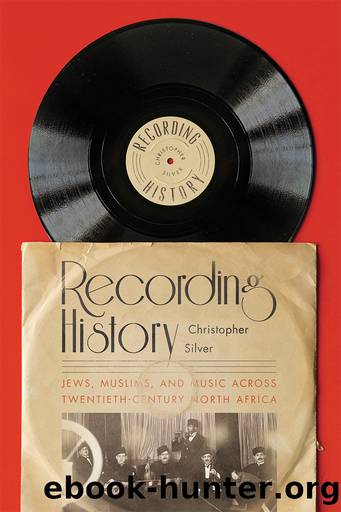Recording History: Jews, Muslims, and Music across Twentieth-Century North Africa by Christopher Silver

Author:Christopher Silver
Language: eng
Format: epub
Publisher: Stanford University Press
Published: 2022-05-15T00:00:00+00:00
FIGURE 17. Advertisement for Salim Halaliâs Casablanca cabaret Le Coq dâOr. Source: The English Language Guide to Morocco, ed. Art Rosett, 1961.
Revolutionary Music
By the early 1950s, Moroccans had begun to imagine independence.65 For many, it may have sounded like Elmaghribi. In tandem with a national struggle waged by the Istiqlal in global forums like the United Nations, Elmaghribi was sating Moroccans back home with what he called his âsensational revolution in Oriental music.â66 And it could be heard nearly everywhere: from the concert hall to the radio and from the royal palace to the marketplace. His revolutionary music celebrated urban and rural, north and south, locations in the French protectorate and the Spanish one, while making no distinction between Arab or Berber nor Muslim or Jew. All were Moroccan. But if his nationalism was more capacious than that of the political parties it was no less nationalist. On the countryâs largest stages and on its most symbolic ones, Elmaghribi donned the national colors, toured alongside Muslims, and sang of and for the nation. In each setting where his music was performed, Elmaghribiâs audiences learned to perform his inclusive brand of Moroccan nationalism as well.
Download
This site does not store any files on its server. We only index and link to content provided by other sites. Please contact the content providers to delete copyright contents if any and email us, we'll remove relevant links or contents immediately.
The Goal (Off-Campus #4) by Elle Kennedy(12450)
Kathy Andrews Collection by Kathy Andrews(10559)
Diary of a Player by Brad Paisley(6872)
What Does This Button Do? by Bruce Dickinson(5537)
Assassin’s Fate by Robin Hobb(5255)
Big Little Lies by Liane Moriarty(4892)
Pale Blue Dot by Carl Sagan(4018)
Sticky Fingers by Joe Hagan(3459)
The Heroin Diaries by Nikki Sixx(2942)
The Death of the Heart by Elizabeth Bowen(2910)
Beneath These Shadows by Meghan March(2730)
The Help by Kathryn Stockett(2708)
Confessions of a Video Vixen by Karrine Steffans(2682)
How Music Works by David Byrne(2539)
Jam by Jam (epub)(2496)
Harry Potter 4 - Harry Potter and The Goblet of Fire by J.K.Rowling(2422)
Strange Fascination: David Bowie: The Definitive Story by David Buckley(2371)
Petty: The Biography by Warren Zanes(2241)
Darker Than the Deepest Sea by Trevor Dann(2214)
